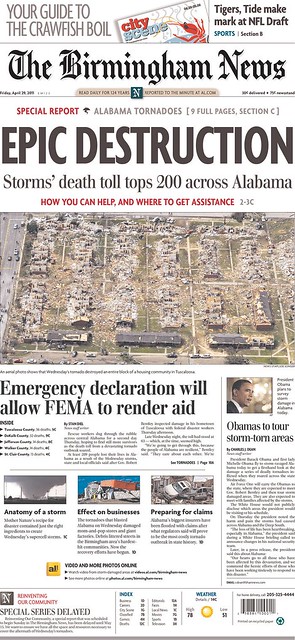Very lucky, as this excellent graphic from the front page of the Tuscaloosa News shows. Note the green area labeled “UA” — that’s the campus, and it just avoided a direct hit from the massive tornado that devastated Tuscaloosa:
As things stand, life at the university has been tremendously disrupted — power out, nearby buildings destroyed, some student housing damaged, final exams canceled, commencement postponed until August, even football season ticket sales delayed — but if the tornado had edged just slightly to the left (or if it had formed a little earlier, and grown to the size it was near Peterson while it was over Tuscaloosa), the campus would have been largely destroyed. Thank God that didn’t happen.
[UPDATE: Since I published this post, it has been confirmed that eight University of Alabama students died in the tornadoes. That’s a tragic loss of life, and I hope my use of the term “lucky” doesn’t seem flippant in light of the news. My point was simply that it could easily have been — and almost was — far, far worse for the university, given the utter devastation just blocks away.]
Here’s another map of storm tracks and death tolls. Of course, this stuff will get much more precise once the National Weather Service sorts it all out, but that will take time, and it’s helpful for us non-Alabamans to see these maps in order to get an initial idea of the disaster’s geography.
The death toll, incidentally, has officially passed 300, though the exact number is hard to pin down. The highest number I’ve seen reported is 313, which would clearly eclipse the Blizzard of 1993 or “Storm of the Century” (highest reported death toll 310; some reports much lower), and might or might not eclipse the Tornado Super Outbreak of 1974 (I’ve seen that toll variously reported as 310, 315 and 330). But the toll is still rising, of course, and the bottom line — as I’ve been saying since yesterday afternoon — is that Wednesday’s tornado outbreak will almost certainly end up as the fifth-deadliest U.S. disaster of any kind in the last 60 years, surpassing the Super Outbreak and trailing only 9/11, Katrina and the 1980 and 1995 heat waves. It also looks likely to be the deadliest tornado outbreak in the U.S. since April 5-6, 1936.
On another note, probably today’s best front page belongs to the Birmingham News:

Epic, indeed.


As of 2:31pm CT Saturday local reports have the Alabama death toll at 254 and compare it to the official death toll from March 21, 1932 of 268. If the student count remains at eight it will be amazing. The two major corridors hit in Tuscaloosa were 15th Street and McFarland Boulevard. 15th Street is/was the home of many apartment buildings catering to students. I visited the area just three weeks ago and cannot fathom what I might see if I were to go back now. The local newsfolk all report that the photos and video do not convey the magnitude of the destruction. Considering what they do convey… well… cannot fathom…
I was ridiculously oblivious to the magnitude of what was occuring as the Pickens-Fayette-Walker-Blount tornado in the graphic took out the power while I was at work 25 miles north of Birmingham. The full picture only became clear when our power was restored 40 hours later but I got the first hint of it by radio as I left work in search of a meal and a wi-fi hotspot. 20 miles of Interstate revealed no electricity anywhere nearby. I later learned the Tuscaloosa tornado plunged about 150,000 customers into darkness as it damaged a main Alabama Power substation as it was crossing Interstate 65 in the northern Birmingham suburb of Fultondale. No wi-fi was to be found so I returned home listening to TV accounts by radio of wandering tornado victims with missing limbs seeking aid in the aftermath. Then the final warning expired and the format returned to music. It was not easy to sleep that night.
I was incredibly lucky. An EF1, two EF2 and an EF4 passed within miles of me and an EF5 was about 50 miles away. My family in both Alabama and Tennessee are all safe and sound. I have yet to learn of a friend who lost their life or was even injured. But it is impossible to be unaffected. The people picking up the pieces are all around and the collective look in their faces reflects what happened over and over again. There may be a goulish aspect to death tolls and injury counts but they serve to quantify the need for help for those left behind. When the devastation is so widespread it is hard to find help from neighbors when they need help just the same.
The ABC affiliate in Birmingham has an excellant weather blog where the unfolding events can be read at http://www.alabamawx.com/ and they produce a netcast called WeatherBrains. http://weatherbrains.com/weatherbrains/ The next show will be a retrospective of the events from last Wednesday.